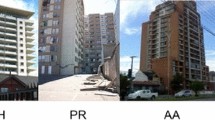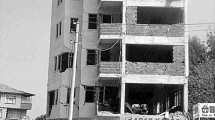Abstract
Reinforced Autoclaved Aerated Concrete (AAC) wall panels are more commonly used to construct load-bearing walls in low-rise prefabricated buildings located in seismic zones. In the scope of this study, the seismic response of buildings constructed with reinforced AAC wall panels was investigated. To this end, an in situ test was conducted on a two-story test building under reversed cyclic displacement excursions. It was determined that the test building could carry a lateral load of 60% more than its weight and has a global displacement ductility of about 3.5. The first story of the building was observed to be critical and the failure of the building was due to overturning response of the whole system. In addition, the proposed numerical models for simulating the behavior of the AAC wall panels were validated. These calibrated numerical models were utilized to conduct nonlinear static analysis of the test building and a reasonably good agreement was observed between the test results and simulations. The results of the incremental dynamic analyses demonstrated that i) the two-story test building could resist strong ground motions with PGA values up to 0.6 g without undergoing significant plastic deformations and ii) a reserve of ductility and over strength is available for the AAC panel building to survive earthquakes with PGAs reaching nearly 0.6 g. Based on these numerical results, reinforced AAC wall panel buildings appear to be good alternatives for low-rise construction in seismic regions.






















Similar content being viewed by others
References
Aldemir A, Binici B, Canbay E, Yakut A (2017) Lateral load testing of an existing two-story masonry building up to near collapse. Bull Earthq Eng 15:3365–3383
Aldemir A, Binici B, Canbay E, Yakut A (2018) In situ lateral load testing of a two-story solid clay brick masonry building. J Perform Construct Facil 32(5):04018058
Al-Shaleh M, Attiogbe EK (1997) Flexural strength characteristics of non-load bearing masonry walls in Kuwait. Mater Struct 30(5):277–283
ASTM (American Society for Testing and Materials) C1692 (2011) Standard practice for construction and testing of autoclaved aerated concrete (AAC) masonry. ASTM International, West Conshohocken
ASTM (American Society for Testing and Materials) C1693 (2011) Standard specification for autoclaved aerated concrete. ASTM International, West Conshohocken
ASTM (American Society for Testing and Materials) E519/E519M (2010) Standard test method for diagonal tension (shear) in masonry assemblages. ASTM International, West Conshohocken
Ayudhya BUN (2016) Comparison of compressive and splitting tensile strength of autoclaved aerated concrete (aac) containing water hyacinth and polypropylene fibre subjected to elevated temperatures. Mater Struct 49:1455–1468
Balkema AA (1992) Advances in autoclaved aerated concrete. In: Proceedings of the 3rd Rilem international symposium, Zurich, 14–16 October
Boggelen WV (2014) History of autoclaved aerated concrete: the short story of a long lasting building material. [http://www.aircrete-europe.com/images/download/en/W.M.%20van%20Boggelen%20-%20History%20of%20Autoclaved%20Aerated%20Concrete.pdf]. Accessed 01 Dec 2017
Costa AA, Penna A, Magenes G (2011) Seismic performance of autoclaved aerated concrete (AAC) masonry: from experimental testing of the in-plane capacity of walls to building response simulation. J Earthq Eng 15(1):1–31
Duan P, Zhang Y, Zhou X, Miao Y (2014) Application of precast aerated concrete panel used as external wallboard in China. Study Civ Eng Archit (SCEA) 3:121–124
Elkashef M, Abdelmooty M (2015) Investigating the use of autoclaved aerated concrete as an infill in reinforced concrete sandwich panels. Mater Struct 48:2133–2146
European Committee for Standardization (2005) Brussels, Belgium. Eurocode 6—Design of masonry structures
Galasco A, Lagomarsino S, Penna A (2002) TREMURI program: seismic analyser of 3D masonry buildings. University of Genoa
Gokmen F (2017) Seismic behavior of autoclaved aerated concrete reinforced vertical panel buildings. MS thesis, Middle East Technical University, Turkey
Hsiao FP, Hwang SJ (2007) In-situ tests of buildings in Rei-Pu elementary school. NCREE research programs and accomplishments. National Center for Research on Earthquake Engineering, Taipei, pp 5–8
Hsiao FP, Chiou TC, Hwang SJ, Chiou YJ (2008) Field test of rc school buildings applying seismic retrofit and evaluation. NCREE research programs and accomplishments. National Center for Research on Earthquake Engineering, Taipei, pp 9–12
Huang X, Ni W, Cui W, Wang Z, Zhu L (2012) Preparation of autoclaved aerated concrete using copper tailings and blast furnace slag. Constr Build Mater 27:1–5
Hunt C (2001) Autoclaved aerated concrete panels and methods of manufacturing, and construction using, autoclaved aerated concrete panels. US Patent No: US 2001/0045070 A1
IMI (2010) Autoclaved aerated concrete masonry units. Team IMI technology brief resource information form the international masonry institute, Issue: February. [http://imiweb.org/wp-content/uploads/2015/10/01.02-AAC-MASONRY-UNITS.pdf]. Accessed 01 Dec 2017
Jerman M, Keppert M, Vyborny J, Cerny R (2013) Hygric, thermal and durability properties of autoclaved aerated concrete. Constr Build Mater 41:352–359
Lagomarsino S, Galasco A, Penna A (2007) Nonlinear macro-element dynamic analysis of masonry buildings. In: Proceedings of the ECCOMAS thematic conference on computational methods in structural dynamics and earthquake engineering, Rethymno, Crete, Greece
Malyszko L, Kowalska E, Bilko P (2017) Splitting tensile behavior of autoclaved aerated concrete: comparison of different specimens’ results. Constr Build Mater 157:1190–1198
Masonry Standards Joint Committee (MSJC) (2011) Building code requirements for masonry structures and specification for masonry structures and commentaries. American Concrete Institute, American Society of Civil Engineers, The Masonry Society, Boulder
Mazzoni S, McKenna F, Scott MH, Fenves GL (2009) OpenSees command language manual. University of California, Berkeley
Milanesi RR, Morandi P, Magenes G (2018) Local effects on RC frames induced by AAC masonry infills through FEM simulation of in-plane tests. Bull Earthq Eng 16:4053–4080
Mousa MA, Uddin N (2009) Experimental and analytical study of carbon fiber-reinforced polymer (FRP)/autoclaved aerated concrete (AAC) sandwich panels. Eng Struct 31:2337–2344
Ottl C, Schellborn H (2007) Examination of the relation between tensile/flexural strength and compressive strength of autoclaved aerated concrete according to prEN 12602. Advances in construction materials. Springer, ISBN: 978-3-540-72447-6
Ozel M (2011) Thermal performance and optimum insulation thickness of building walls with different structure materials. Appl Therm Eng 31:3854–3863
Penna A, Mandirola M, Rota M, Magenes G (2015) Experimental assessment of the in-plane lateral capacity of autoclaved aerated concrete (AAC) masonry walls with flat-truss bed-joint reinforcement. Constr Build Mater 82:155–166
Quagliarini E, Maracchini G, Clementi F (2017) Uses and limits of the Equivalent Frame Model on existing unreinforced masonry buildings for assessing their seismic risk: A review. J Build Eng 10:166–182
Ravichandran SS, Klingner RE (2012) Behavior of steel moment frames with autoclaved aerated concrete infills. ACI Struct J 109(1):83–90
Riepe FW (2009) Method of autoclaved aerated concrete (AAC) wall construction. US Patent No: US 2010/0229489 A1
Schwarz S, Hanaor A, Yankelevsky DZ (2015) Experimental response of reinforced concrete frames with AAC MASONRY INfiLL WALLS TO IN-PLANE CYCLIC LOADing. Structures 3:306–319
Shih CT, Chu SY, Liou YW, Hsiao FP, Huang CC, Chiou TC, Chiou YC (2015) In situ test of school buildings retrofitted with external steel-framing systems. J Struct Eng ASCE 141(1):1–18
Siano R, Roca R, Camata G, Pelà L, Sepe V, Spacone E, Petracca M (2018) Numerical investigation of non-linear equivalent-frame models for regular masonry walls. Eng Struct 173:512–529
Taghipour A (2016) Seismic behavior of vertical reinforced autoclaved aerated concrete (AAC) panel walls. MS Thesis, Middle East Technical University, Turkey
Tanner JE (2003) Design provisions for autoclaved aerated concrete (AAC) structural systems. Ph.D. thesis, The University of Texas at Austin, USA
Tanner J, Varela J, Brightman M, Cancino U, Argudo J, Klingner R (2005) Seismic testing of autoclaved aerated concrete shearwalls: a comprehensive review. ACI Struct J 102(3):374–382
Turkish Earthquake Code (TEC2017) Specifications for the buildings to be constructed in disaster areas draft version. Ministry of Public Works and Settlement, Ankara, Turkey
Varela JL (2003) Development of R and Cd factors for the seismic design of AAC structures. Ph.D. thesis, Department of Civil Engineering, University of Texas at Austin, USA
Varela-Rivera J, Fernandez-Baqueiro L, Alcocer-Canche R, Ricalde-Jimenez J, Chim-May R (2018) Shear and flexural behavior of autoclaved aerated concrete confined masonry walls. ACI Struct J 115(5):1453–1462
Vekey RC, Bright NJ, Luckin KR, Arora SK (1986) The resistance of masonry to lateral loading. pt. 3. Research results on autoclaved aerated concrete blockwork. Struct Eng 64A(11):9
Wang B, Wang P, Chen Y, Zhou J, Kong X, Wu H, Fan H, Jin F (2017) Blast responses of CFRP strengthened autoclaved aerated cellular concrete panels. Constr Build Mater 157:226–236
Xella Aircrete North America, Inc. (2010) Technical manual. Retrieved on August 14, 2017, from [http://www.hebel-usa.com/en/content/technical_manual_1795.php]
Zovkic J, Sigmund V, Guljas I (2013) Cyclic testing of a single bay reinforced concrete frames with various types of masonry infill. Earthq Eng Struct Dyn 42:1131–1149
Acknowledgements
Authors acknowledge the financial support provided by Turkish Autoclaved Aerated Concrete Association (TAACA). The second author acknowledges the support from TUBA-GEBIP for continuing research endeavors. The contributions of Salim Azak and METU Structural Mechanics Laboratory technicians Osman Keskin, Murat Demirel and Barıs Esen during the site and laboratory work are also gratefully acknowledged.
Author information
Authors and Affiliations
Corresponding author
Additional information
Publisher's Note
Springer Nature remains neutral with regard to jurisdictional claims in published maps and institutional affiliations.
Rights and permissions
About this article
Cite this article
Gokmen, F., Binici, B., Aldemir, A. et al. Seismic behavior of autoclaved aerated concrete low rise buildings with reinforced wall panels. Bull Earthquake Eng 17, 3933–3957 (2019). https://doi.org/10.1007/s10518-019-00630-3
Received:
Accepted:
Published:
Issue Date:
DOI: https://doi.org/10.1007/s10518-019-00630-3




